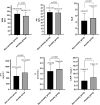Analysis of the prevalence and influencing factors of depression and anxiety among maintenance dialysis patients during the COVID-19 pandemic
- PMID: 33675473
- PMCID: PMC7936244
- DOI: 10.1007/s11255-021-02791-0
Analysis of the prevalence and influencing factors of depression and anxiety among maintenance dialysis patients during the COVID-19 pandemic
Abstract
Objective: Currently, the COVID-19 outbreak and its spread around the globe is significantly affecting mental health and health in general, worldwide. During the COVID-19 pandemic, the general medical complications have received the most attention, whereas only a few studies address the potential direct impact of SARS-CoV-2 on mental health.
Methods: A total of 321 maintenance hemodialysis (MHD) patients were selected using random sampling from the hemodialysis center of the second people's Hospital of Yibin. They completed Zung's self-rating anxiety scale (SAS) for anxiety, Zung's self-rating depression scale (SDS) for depression, and the activity of daily living scale (ADL) for the ability of living. Demographic data and laboratory tests were used to analyze the risk factors.
Results: The proportions of the prevalence of anxiety and depression symptoms were between 34.89% and 30.02%, respectively, among the MHD patients. The SAS and SDS scores of the 321 patients were 45.42(± 10.99) and 45.23(± 11.59), respectively. The results show that monthly income, medical insurance, vascular access, the duration of dialysis, complication, hemoglobin (HGB), immunoreactive parathyroid hormone (iPTH) and blood phosphorus (P) are factors that influence anxiety among patients (p < 0.05 for all). Vascular access, monthly income, medical insurance, complication, CRP, Alb, are factors that influence depression among patients (p < 0.05 for all).
Conclusion: Our results suggest that during the pandemic period, the prevalence of anxiety and depression symptoms among MHD patients increased. Some demographic and clinical variables were associated with it. We should, therefore, pay more attention to the patients' psychology, start targeted intervention to alleviate the patients' anxiety and further improve their quality of life.
Keywords: Anxiety; COVID-19; Depression; Logistic models; Maintenance hemodialysis.
Conflict of interest statement
The authors declare no conflict of interest in preparing this article.
Figures






Similar articles
-
The Situation and Influencing Factors of Depression and Anxiety in Patients of Hemodialysis during the COVID-19 Pandemic in China.Healthcare (Basel). 2023 Mar 24;11(7):941. doi: 10.3390/healthcare11070941. Healthcare (Basel). 2023. PMID: 37046867 Free PMC article.
-
Prevalence of anxiety and depression symptoms, and association with epidemic-related factors during the epidemic period of COVID-19 among 123,768 workers in China: A large cross-sectional study.J Affect Disord. 2020 Dec 1;277:495-502. doi: 10.1016/j.jad.2020.08.041. Epub 2020 Aug 26. J Affect Disord. 2020. PMID: 32882506 Free PMC article.
-
Investigation on the mental health status of pregnant women in China during the Pandemic of COVID-19.Arch Gynecol Obstet. 2021 Feb;303(2):463-469. doi: 10.1007/s00404-020-05805-x. Epub 2020 Oct 3. Arch Gynecol Obstet. 2021. PMID: 33009997 Free PMC article.
-
Depression and Anxiety Among Patients with Cancer During COVID-19 Pandemic: A Systematic Review and Meta-analysis.J Gastrointest Cancer. 2021 Jun;52(2):499-507. doi: 10.1007/s12029-021-00643-9. Epub 2021 May 5. J Gastrointest Cancer. 2021. PMID: 33950368 Free PMC article.
-
Prevalence and risk factors for elevated anxiety symptoms and anxiety disorders in chronic kidney disease: A systematic review and meta-analysis.Gen Hosp Psychiatry. 2021 Mar-Apr;69:27-40. doi: 10.1016/j.genhosppsych.2020.12.003. Epub 2020 Dec 15. Gen Hosp Psychiatry. 2021. PMID: 33516963
Cited by
-
Analysis of risk factors for depression in peritoneal dialysis patients and establishment of a risk nomogram model.Clinics (Sao Paulo). 2025 Feb 13;80:100600. doi: 10.1016/j.clinsp.2025.100600. eCollection 2025. Clinics (Sao Paulo). 2025. PMID: 39951876 Free PMC article.
-
Self-care self-efficacy and depression associated with quality of life among patients undergoing hemodialysis in Vietnam.PLoS One. 2022 Jun 16;17(6):e0270100. doi: 10.1371/journal.pone.0270100. eCollection 2022. PLoS One. 2022. PMID: 35709232 Free PMC article.
-
Depression and death anxiety among patients undergoing hemodialysis during the COVID-19 pandemic in Palestine: a cross sectional study.Front Psychiatry. 2023 Aug 31;14:1247801. doi: 10.3389/fpsyt.2023.1247801. eCollection 2023. Front Psychiatry. 2023. PMID: 37720896 Free PMC article.
-
Identification of discriminative neuroimaging markers for patients on hemodialysis with insomnia: a fractional amplitude of low frequency fluctuation-based machine learning analysis.BMC Psychiatry. 2023 Jan 4;23(1):9. doi: 10.1186/s12888-022-04490-1. BMC Psychiatry. 2023. PMID: 36600230 Free PMC article.
-
Prevalence of depression and anxiety and their predictors among patients undergoing maintenance hemodialysis in Northern China: a cross-sectional study.Ren Fail. 2022 Dec;44(1):933-944. doi: 10.1080/0886022X.2022.2077761. Ren Fail. 2022. PMID: 35618386 Free PMC article.
References
MeSH terms
LinkOut - more resources
Full Text Sources
Other Literature Sources
Medical
Research Materials
Miscellaneous

